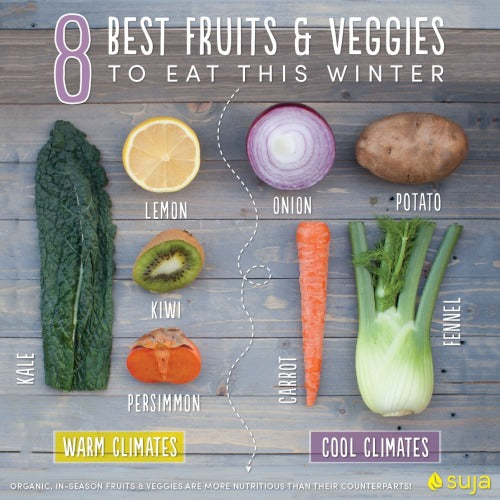· By Sam Swensen
8 Best Fruits and Veggies to Eat this Winter
 Once upon a time, in-season fruits and veggies were the only type you could find at the local market. Today, out-of-season produce is readily available at all of today's mass supermarkets, often with no indication of where it comes from. As nice as it may be to have such a wide selection year round, you don’t get the same nutritional benefits from out-of-season produce that you do from local, in-season produce. (1)
Out-of-season produce has to travel across long distances, sometimes across the globe! (2) Doesn’t exactly scream “fresh”, does it? To ensure that they don't spoil on the trip, these fruits and veggies are often picked while immature, meaning less vitamins and nutrients. (1)
While it’s not exactly known for its fresh produce, the winter offers a surprising range of in-season options from hardy root vegetables to bright, sweet citrus fruits. Here’s a list of our favorite winter fruits and veggies and why we love them. (3)
In cooler climates:
Potatoes: Although starchy and a bit high on the glycemic index, potatoes are satiating and boast an impressive amount of potassium, magnesium, folic acid, vitamin C and protein. (4)
Onions: These unassuming veggies are low in calories but surprisingly high in vitamin C and fiber. (5)
Fennel: Fennel has a boatload of vitamins and minerals like vitamin C, potassium, magnesium, and copper. (6)
Carrots: With this familiar powerfood, you get vitamin A and a host of other benefits. (6)
Warm climates:
Lemons: Lemons are alkalizing for the body and rich in vitamin C and flavonoids that work against infections like the flu and colds (7)
Leafy greens: These veggies are rich in vitamins A, C, K, and E, as well as iron, calcium, manganese, potassium, and phytochemicals and antioxidants. (4)
Kiwis: The fuzzy little kiwi is higher in Vitamin C than most fruits and also packs the vital nutrients vitamin E, copper, vitamin K, choline, magnesium and phosphorus. (8)
Persimmons: They contain significantly higher concentrations of the dietary fiber, minerals and phenolic compounds. (9)
Cheers,
Sam Swensen & Suja Juice
SOURCES:
1. Lawrence, Robinson. "Are Organic Foods Right for You?" Understanding the Benefits of Organic Food and the Risks of GMOs and Pesticides. HelpGuide.org, 1 Aug. 2015. Web. http://www.helpguide.org/articles/healthy-eating/organic-foods.htm
2. Morris, Michele. "Benefits of Eating What's in Season." Benefits of Eating What’s in Season. GAIAM Foundation, 2014. Web. http://life.gaiam.com/article/benefits-eating-what-s-season
3. Webber, Glenda. "Genetically Engineered Fruits and Vegetables." Genetically Engineered Fruits and Vegetables. U.S. Department of Agriculture, 1 Nov. 1994. Web. http://www.aces.uiuc.edu/vista/html_pubs/biotech/genen.htm
4. "Top 10 Foods Highest in Potassium You Can't Miss." Top 10 Foods Highest in Potassium You Can't Miss. Healthaliciousness.com, 2015. Web. http://www.healthaliciousness.com/articles/food-sources-of-potassium.php
5. Szalay, Jessie. "Onions: Health Benefits, Health Risks & Nutrition Facts." LiveScience. TechMedia Network, 16 Oct. 2014. Web. http://www.livescience.com/45293-onion-nutrition.html.
6. Breene, Sophie. "The Best Fruits and Vegetables to Eat This Winter." The Best Fruits and Vegetables to Eat This Winter. Northeast Ohio Media Group., 11 Dec. 2013. Web. http://www.cleveland.com/cooking/index.ssf/2013/12/the_best_fruits_and_vegetables.html
7. Berhow, Bennett. "Lemons/Limes." WHFoods.com. The George Mateljan Foundation, 1 July 1994. Web. http://www.whfoods.com/genpage.php?tname=foodspice&dbid=2
8. Hill, Peter. "Kiwifruit: Health Benefits, Nutritional Breakdown." Medical News Today. MediLexicon International. Web. http://www.medicalnewstoday.com/articles/271232.php
9. Gorinstein, Shela, Zofia Zachwieja, Maria Folta, Henryk Barton, Jadwiga Piotrowicz, Marina Zemser, Moshe Weisz, Simon Trakhtenberg, and Olga Màrtín-Belloso. "Comparative Contents of Dietary Fiber, Total Phenolics, and Minerals in Persimmons and Apples." J. Agric. Food Chem. Journal of Agricultural and Food Chemistry (2000): 952-57. Comparative Contents of Dietary Fiber, Total Phenolics, and Minerals in Persimmons and Apples. Department of Medicinal Chemistry, School of Pharmacy. Web. http://www.academia.edu/6182416/Comparative_Contents_of_Dietary_Fiber_Total_Phenolics_and_Minerals_in_Persimmons_and_Apples
Once upon a time, in-season fruits and veggies were the only type you could find at the local market. Today, out-of-season produce is readily available at all of today's mass supermarkets, often with no indication of where it comes from. As nice as it may be to have such a wide selection year round, you don’t get the same nutritional benefits from out-of-season produce that you do from local, in-season produce. (1)
Out-of-season produce has to travel across long distances, sometimes across the globe! (2) Doesn’t exactly scream “fresh”, does it? To ensure that they don't spoil on the trip, these fruits and veggies are often picked while immature, meaning less vitamins and nutrients. (1)
While it’s not exactly known for its fresh produce, the winter offers a surprising range of in-season options from hardy root vegetables to bright, sweet citrus fruits. Here’s a list of our favorite winter fruits and veggies and why we love them. (3)
In cooler climates:
Potatoes: Although starchy and a bit high on the glycemic index, potatoes are satiating and boast an impressive amount of potassium, magnesium, folic acid, vitamin C and protein. (4)
Onions: These unassuming veggies are low in calories but surprisingly high in vitamin C and fiber. (5)
Fennel: Fennel has a boatload of vitamins and minerals like vitamin C, potassium, magnesium, and copper. (6)
Carrots: With this familiar powerfood, you get vitamin A and a host of other benefits. (6)
Warm climates:
Lemons: Lemons are alkalizing for the body and rich in vitamin C and flavonoids that work against infections like the flu and colds (7)
Leafy greens: These veggies are rich in vitamins A, C, K, and E, as well as iron, calcium, manganese, potassium, and phytochemicals and antioxidants. (4)
Kiwis: The fuzzy little kiwi is higher in Vitamin C than most fruits and also packs the vital nutrients vitamin E, copper, vitamin K, choline, magnesium and phosphorus. (8)
Persimmons: They contain significantly higher concentrations of the dietary fiber, minerals and phenolic compounds. (9)
Cheers,
Sam Swensen & Suja Juice
SOURCES:
1. Lawrence, Robinson. "Are Organic Foods Right for You?" Understanding the Benefits of Organic Food and the Risks of GMOs and Pesticides. HelpGuide.org, 1 Aug. 2015. Web. http://www.helpguide.org/articles/healthy-eating/organic-foods.htm
2. Morris, Michele. "Benefits of Eating What's in Season." Benefits of Eating What’s in Season. GAIAM Foundation, 2014. Web. http://life.gaiam.com/article/benefits-eating-what-s-season
3. Webber, Glenda. "Genetically Engineered Fruits and Vegetables." Genetically Engineered Fruits and Vegetables. U.S. Department of Agriculture, 1 Nov. 1994. Web. http://www.aces.uiuc.edu/vista/html_pubs/biotech/genen.htm
4. "Top 10 Foods Highest in Potassium You Can't Miss." Top 10 Foods Highest in Potassium You Can't Miss. Healthaliciousness.com, 2015. Web. http://www.healthaliciousness.com/articles/food-sources-of-potassium.php
5. Szalay, Jessie. "Onions: Health Benefits, Health Risks & Nutrition Facts." LiveScience. TechMedia Network, 16 Oct. 2014. Web. http://www.livescience.com/45293-onion-nutrition.html.
6. Breene, Sophie. "The Best Fruits and Vegetables to Eat This Winter." The Best Fruits and Vegetables to Eat This Winter. Northeast Ohio Media Group., 11 Dec. 2013. Web. http://www.cleveland.com/cooking/index.ssf/2013/12/the_best_fruits_and_vegetables.html
7. Berhow, Bennett. "Lemons/Limes." WHFoods.com. The George Mateljan Foundation, 1 July 1994. Web. http://www.whfoods.com/genpage.php?tname=foodspice&dbid=2
8. Hill, Peter. "Kiwifruit: Health Benefits, Nutritional Breakdown." Medical News Today. MediLexicon International. Web. http://www.medicalnewstoday.com/articles/271232.php
9. Gorinstein, Shela, Zofia Zachwieja, Maria Folta, Henryk Barton, Jadwiga Piotrowicz, Marina Zemser, Moshe Weisz, Simon Trakhtenberg, and Olga Màrtín-Belloso. "Comparative Contents of Dietary Fiber, Total Phenolics, and Minerals in Persimmons and Apples." J. Agric. Food Chem. Journal of Agricultural and Food Chemistry (2000): 952-57. Comparative Contents of Dietary Fiber, Total Phenolics, and Minerals in Persimmons and Apples. Department of Medicinal Chemistry, School of Pharmacy. Web. http://www.academia.edu/6182416/Comparative_Contents_of_Dietary_Fiber_Total_Phenolics_and_Minerals_in_Persimmons_and_Apples
